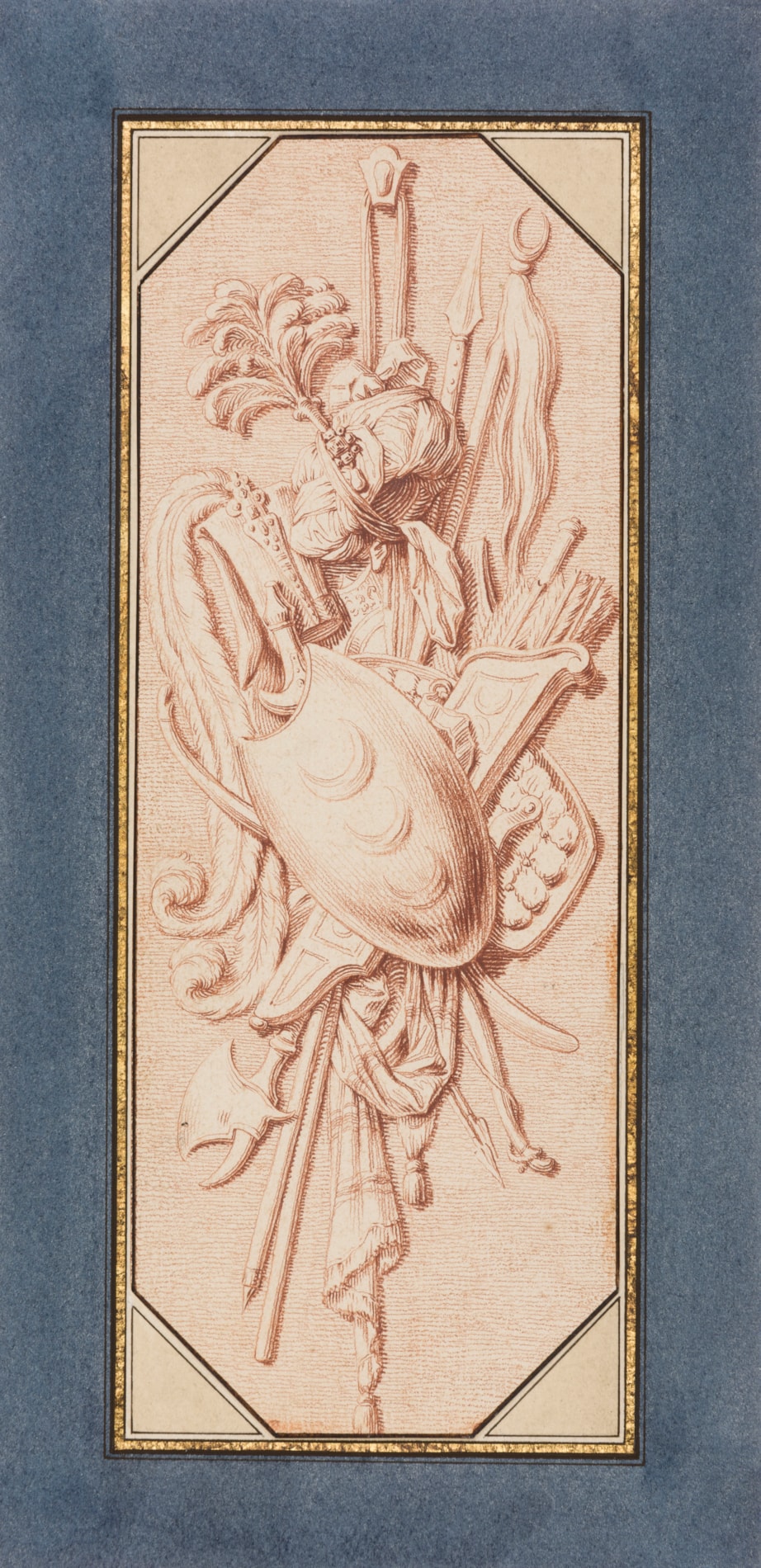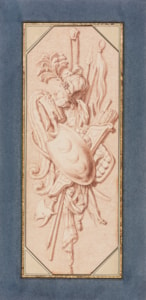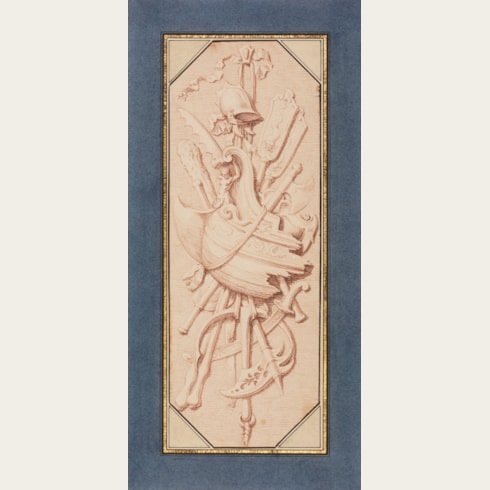Jacques DUMONT LE ROMAIN
(Paris 1701 - Paris 1781)
Design for a Trophy: Les Arms Ottomans
Sold
Red chalk, with framing lines in brown ink.
All four corners of the sheet cut.
327 x 122 mm. (12 7/8 x 4 3/4 in.)
All four corners of the sheet cut.
327 x 122 mm. (12 7/8 x 4 3/4 in.)
The present sheet is a preparatory study for the right hand image on plate 6 of the 'Livre de nouveaux trophées inventez par J. Dumont le Romain', published in c.1736.
Four other preparatory drawings by Dumont le Romain for this set of engravings are known, all in red chalk and closely comparable to this pair of drawings. A red chalk design for a trophy of musical instruments, signed and dated 1736, is in the collection of the Ecole des Beaux-Arts in Paris, while another similar drawing of a trophy with attributes of the arts, also signed and dated 1736, is in the Kunstbibliothek in Berlin. Two further drawings of trophies by Dumont for the Livre de nouveaux trophées, formerly in the Beurdeley collection, are today in the Hermitage in Saint Petersburg.
The present pair of drawings is very likely to have originally been signed and dated by the artist in red chalk at the lower left and right corners, as is found in the related drawings in Paris and Berlin, but these would have been lost when the corners of the sheets were cut.
These two drawings by Dumont le Romain may once have been part of the extensive collection of the designer Edward C. Moore (1827-1891), who worked as the head silversmith at Tiffany and Company during the latter half of the 19th century. Moore assembled a large study collection of several thousand objects, predominantly of Islamic art, and some five hundred books. Much of the collection was left to the Metropolitan Museum of Art in New York after Moore’s death in 1891.
A copy of the present sheet by an anonymous 18th century artist appears on the verso of a pen and ink drawing of a design for an altar, formerly in the Lodewijk Houthakker collection in Amsterdam.
Dumont le Romain’s designs for trophies and decorations represents a still little-studied aspect of his drawn oeuvre. Nevertheless, as the scholar Peter Fuhring has recently pointed out, ‘Dumont shows himself more inventive in his projects for trophies, which are rare and little known today.’ Fuhring further notes that the first half of the 18th century in France saw several artists create designs for trophies, including the sculptor François-Antoine Vassé, the painter and decorator Christophe Huet and the decorator and ornamental designer Alexis Peyrotte. Apart from the series of trophy designs by Dumont le Romain of c.1736, the printmaker and publisher Gabriel Huquier also issued two other sets of engravings of trophy designs the same year, based on designs by the sculptor René Charpentier.
Four other preparatory drawings by Dumont le Romain for this set of engravings are known, all in red chalk and closely comparable to this pair of drawings. A red chalk design for a trophy of musical instruments, signed and dated 1736, is in the collection of the Ecole des Beaux-Arts in Paris, while another similar drawing of a trophy with attributes of the arts, also signed and dated 1736, is in the Kunstbibliothek in Berlin. Two further drawings of trophies by Dumont for the Livre de nouveaux trophées, formerly in the Beurdeley collection, are today in the Hermitage in Saint Petersburg.
The present pair of drawings is very likely to have originally been signed and dated by the artist in red chalk at the lower left and right corners, as is found in the related drawings in Paris and Berlin, but these would have been lost when the corners of the sheets were cut.
These two drawings by Dumont le Romain may once have been part of the extensive collection of the designer Edward C. Moore (1827-1891), who worked as the head silversmith at Tiffany and Company during the latter half of the 19th century. Moore assembled a large study collection of several thousand objects, predominantly of Islamic art, and some five hundred books. Much of the collection was left to the Metropolitan Museum of Art in New York after Moore’s death in 1891.
A copy of the present sheet by an anonymous 18th century artist appears on the verso of a pen and ink drawing of a design for an altar, formerly in the Lodewijk Houthakker collection in Amsterdam.
Dumont le Romain’s designs for trophies and decorations represents a still little-studied aspect of his drawn oeuvre. Nevertheless, as the scholar Peter Fuhring has recently pointed out, ‘Dumont shows himself more inventive in his projects for trophies, which are rare and little known today.’ Fuhring further notes that the first half of the 18th century in France saw several artists create designs for trophies, including the sculptor François-Antoine Vassé, the painter and decorator Christophe Huet and the decorator and ornamental designer Alexis Peyrotte. Apart from the series of trophy designs by Dumont le Romain of c.1736, the printmaker and publisher Gabriel Huquier also issued two other sets of engravings of trophy designs the same year, based on designs by the sculptor René Charpentier.
The son of a sculptor and the brother of an architect, Jacques (or Jean) Dumont first studied with the landscape painter Antoine Lebel. He seems to have received his nickname of ‘Dumont le Romain’ from the fact that, as a young art student, he is said to have walked from Paris to Rome, where he completed his studies over the next few years. During his five years in Rome he made drawings after the Antique as well as copies of paintings by such Italian artists as Benedetto Luti. Three years after his return to France in 1725, Dumont was received into the Académie Royale, having submitted as his reception piece a painting of Hercules and Omphale that is today in the Musée des Beaux-Arts in Tours. He exhibited at the Salons between 1737 and 1761, and taught at the Académie for many years, serving as professor and rector before eventually being named honorary director of the institution in 1768. Apparently a man of somewhat difficult temperament, Dumont was also briefly the first governor of the Ecole des Elèves Protégés in 1748, before being replaced, after a few months, by Carle Vanloo.
Dumont worked as a history painter of Biblical subjects and mythological scenes, and also painted genre subjects and portraits. Among his significant public commissions were a painting of The Meeting of Saint Francis de Paul and Louis IX at the Château of Plessis-les-Tours for the church of the Pères Minimes in Paris in 1730, and a large allegorical canvas of The Signing of the Peace Treaty of Aix-la-Chapelle in 1748, painted in 1761 for the Hôtel de Ville in Paris and today in the Musée Carnavalet. In 1748 Dumont painted a series of overdoors of allegorical subjects for the Château de la Muette, today in the Louvre, and in 1752 he designed a set of tapestries on the theme of Samson for the Gobelins manufactory; a project that was eventually abandoned, although at least two preparatory drawings survive.
Dumont rarely exhibited his work, although paintings by him were shown at the Salons between 1737 and 1761. Several years after Dumont’s death, the engraver, collector and biographer Jean-Baptiste-Denis Lempereur wrote somewhat disparagingly of him that ‘This artist was lacking in imagination; he could only compose with the help of prints…His drawing was mannered although fairly correct; he had some skill with the brush and a sort of colour. In spite of that, his paintings are affected by his lack of facility, and by the aversion that he felt all his life for work.’ Perhaps partly as a result of such criticism, Dumont’s relatively small oeuvre as a painter and draughtsman remains little studied today, by comparison with many of his contemporaries.
As a draughtsman, Dumont displayed a distinct preference for red chalk, and produced several drawn copies after the work of Italian masters, as well as nude academies, studies of heads, and a handful of decorative designs. Drawings by the artist are in the collections of the Hessisches Landesmuseum in Darmstadt, the National Galleries of Scotland in Edinburgh, the Musée des Beaux-Arts in Nancy, the Pierpont Morgan Library and the Metropolitan Museum of Art in New York, the Ecole des Beaux-Arts and the Louvre in Paris, the Nationalmuseum in Stockholm, the Goethe-Nationalmuseum in Weimar, and elsewhere.
Dumont worked as a history painter of Biblical subjects and mythological scenes, and also painted genre subjects and portraits. Among his significant public commissions were a painting of The Meeting of Saint Francis de Paul and Louis IX at the Château of Plessis-les-Tours for the church of the Pères Minimes in Paris in 1730, and a large allegorical canvas of The Signing of the Peace Treaty of Aix-la-Chapelle in 1748, painted in 1761 for the Hôtel de Ville in Paris and today in the Musée Carnavalet. In 1748 Dumont painted a series of overdoors of allegorical subjects for the Château de la Muette, today in the Louvre, and in 1752 he designed a set of tapestries on the theme of Samson for the Gobelins manufactory; a project that was eventually abandoned, although at least two preparatory drawings survive.
Dumont rarely exhibited his work, although paintings by him were shown at the Salons between 1737 and 1761. Several years after Dumont’s death, the engraver, collector and biographer Jean-Baptiste-Denis Lempereur wrote somewhat disparagingly of him that ‘This artist was lacking in imagination; he could only compose with the help of prints…His drawing was mannered although fairly correct; he had some skill with the brush and a sort of colour. In spite of that, his paintings are affected by his lack of facility, and by the aversion that he felt all his life for work.’ Perhaps partly as a result of such criticism, Dumont’s relatively small oeuvre as a painter and draughtsman remains little studied today, by comparison with many of his contemporaries.
As a draughtsman, Dumont displayed a distinct preference for red chalk, and produced several drawn copies after the work of Italian masters, as well as nude academies, studies of heads, and a handful of decorative designs. Drawings by the artist are in the collections of the Hessisches Landesmuseum in Darmstadt, the National Galleries of Scotland in Edinburgh, the Musée des Beaux-Arts in Nancy, the Pierpont Morgan Library and the Metropolitan Museum of Art in New York, the Ecole des Beaux-Arts and the Louvre in Paris, the Nationalmuseum in Stockholm, the Goethe-Nationalmuseum in Weimar, and elsewhere.
Provenance
Possibly Edward C. Moore, New York
His sale, Neuilly-sur-Seine, Hôtel des Ventes, 12 December 2005, part of lot 17
W. M. Brady and Co., New York
Private collection.
His sale, Neuilly-sur-Seine, Hôtel des Ventes, 12 December 2005, part of lot 17
W. M. Brady and Co., New York
Private collection.






